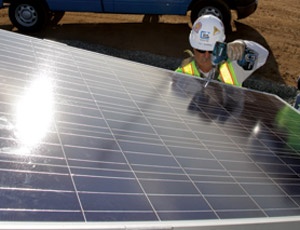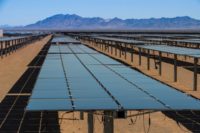Southern California Edison (SCE) plans to install 250 MW of solar generating capacity in California�s southern and central valley in the next four years. Another 250 MW could be secured through contracts with independent energy providers as part of the utility�s $875 million initiative. The first round of long-term power purchase contracts was let to independent power producers in July of this year. The second round of contracts could hit the streets during the first quarter of 2011.

Power could come from some 100 stations, starting with 50 MW scheduled for completion by the end of 2010. Already under construction are 10 sites in San Bernardino County covering 5.3 sq ft of rooftops leased from Denver, Colo.-based ProLogis for a total of 25.32 MW.
SCE spokesman Gil Alexander said the plan was to lease rooftop space from warehouse building owners with little power demand - and thus little incentive to install rooftop generation. �[Thus] covering their roofs with solar panels, and sending the power into the neighborhood to serve all utility customers,� Alexander said.
While much of the distribution will be rooftop mounted, the largest � an $18 million, 6.7 MW station in Porterville on city-owned industrial property � is being ground mounted by San Jose-based Cupertino Electric, Inc. The 29,000-panel solar farm on 35 acres in the San Joaquin Valley is considered the largest utility-owned photovoltaic solar facility in the state. The central location allows SCE to patch the supply directly into the nearby distribution system instead of routing it through a substation. The project broke ground September 20 and will be completed in mid-December. Cupertino Electric spokesperson Autumn Casadonte said the project would normally have taken nine months for a crew of 30 to complete; instead, they are using a team of 120 to finish the work in three months.
SCE expects to have the first 50 megawatts of solar PV generating capacity online or in the final stage of construction by the end of 2010. They will add an additional 50 MW of construction activity each of the next four years until the full 250 MW is online. The utility fast-tracked the first three installations �in order to begin gaining experience with the most efficient and cost-effective ways of developing the project,� Alexander said. The state recently increased the renewable energy goal to 33% by 2020 and 20% by 2012.
Because of economies of scale, SCE hopes to install the generating capacity at half the $7 prevailing cost of installed PV generation, as estimated by the California Solar Initiative. �We predicted, and are on schedule to deliver, an installed cost of $3.50 per watt,� Alexander said.


Post a comment to this article
Report Abusive Comment